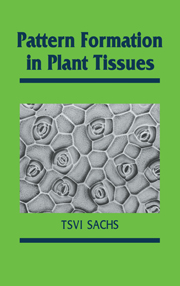Book contents
- Frontmatter
- Contents
- Preface
- 1 Introduction
- 2 Interactions of developing organs
- 3 Hormones as correlative agents
- 4 Callus and tumor development
- 5 The polarization of tissues
- 6 The canalization of vascular differentiation
- 7 Cell lineages
- 8 Stomata as an example of meristemoid development
- 9 Expressions of cellular interactions
- 10 Apical meristems
- 11 The localization of new leaves
- 12 A temporal control of apical differentiation
- 13 Generalizations about tissue patterning
- References
- Author Index
- Subject Index
12 - A temporal control of apical differentiation
Published online by Cambridge University Press: 05 October 2009
- Frontmatter
- Contents
- Preface
- 1 Introduction
- 2 Interactions of developing organs
- 3 Hormones as correlative agents
- 4 Callus and tumor development
- 5 The polarization of tissues
- 6 The canalization of vascular differentiation
- 7 Cell lineages
- 8 Stomata as an example of meristemoid development
- 9 Expressions of cellular interactions
- 10 Apical meristems
- 11 The localization of new leaves
- 12 A temporal control of apical differentiation
- 13 Generalizations about tissue patterning
- References
- Author Index
- Subject Index
Summary
A few facts can be used to introduce the topic. A shoot apex on a rose bush starts its development by repeatedly producing photosynthetic leaves that resemble one another. Sooner or later the apex changes – it undergoes a process of ‘maturation’ – and forms the various organs of a flower. Flower formation terminates apical development. This is an example of a differentiation of an apex that results in an ordered spatial distribution of organs along the stem. In a less dramatic form, a similar differentiation is evident in plants in which the flowers are not terminal. For example, in peas the shoot apex of seedling forms leaves with only vegetative buds in their axils; a change is expressed by the appearance of axillary flower primordia rather than vegetative buds. The apex may continue to form leaves and reproductive buds for a long time, so the differentiation need not terminate apical development.
The transition from vegetative to reproductive development is often not a characteristic of an entire plant but rather of individual shoot apices. This must mean that differences between these apices could not be due to the environment but rather to responses to the environment which are dependent on internal differentiation. It is also possible to separate internal processes from the effects of the environment by observing the differentiation of apices in plants kept in uniform conditions.
- Type
- Chapter
- Information
- Pattern Formation in Plant Tissues , pp. 162 - 178Publisher: Cambridge University PressPrint publication year: 1991

